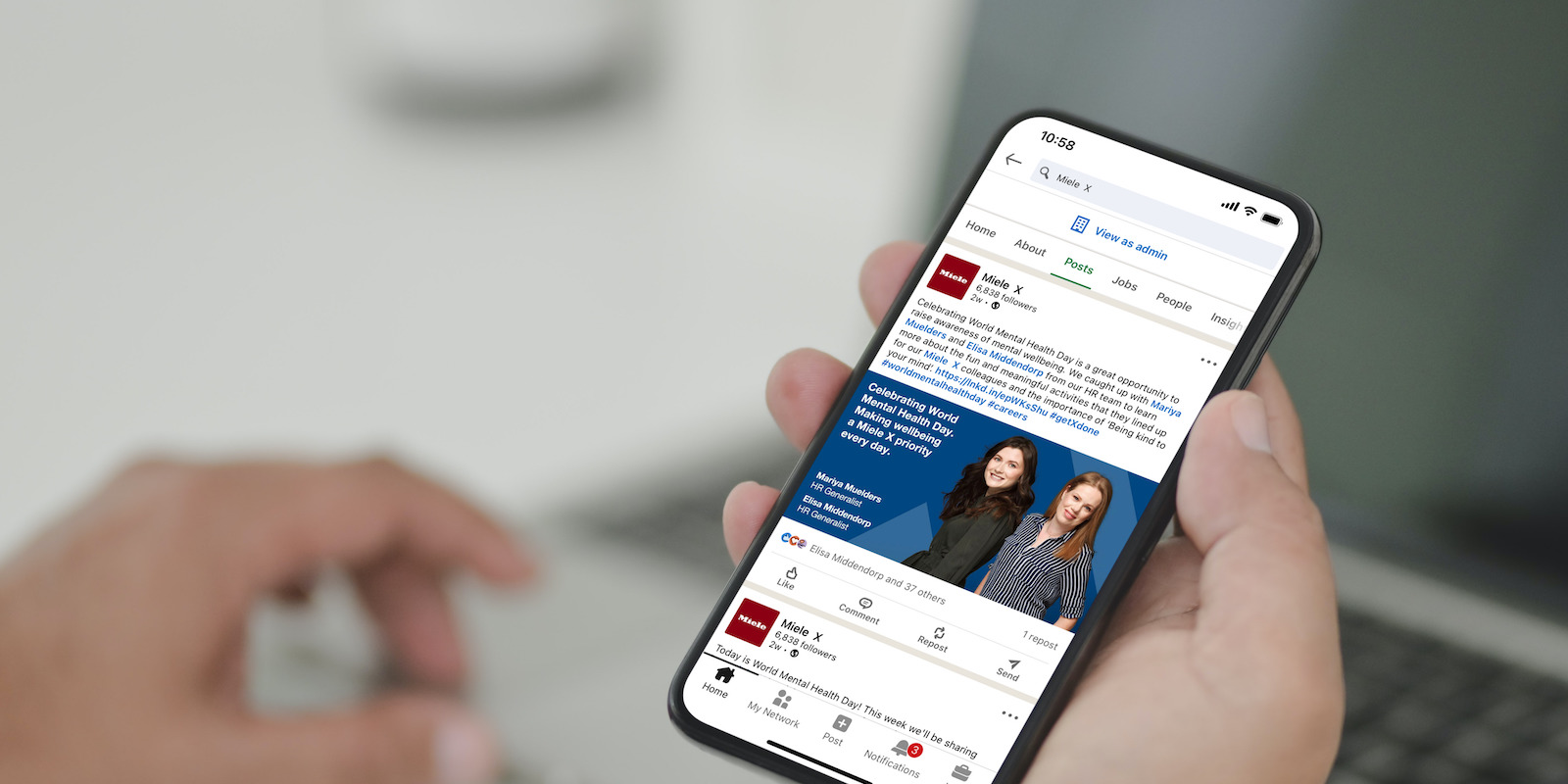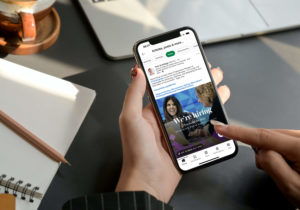If you are going to use a social network to promote your employer brand, don’t go anywhere until you have mastered LinkedIn. We don’t need to dangle the latest stats to confirm what all recruiters know – LinkedIn is a thriving community of potential candidates and customers of your employer brand. And the number of users is increasing at speed.
This article has been updated to cover the major changes LinkedIn made to its algorithm, announced in June 2023. LinkedIn wants to see more knowledge and advice – and less of the selfies and ‘Facebooky’ content that’s been creeping in since the pandemic. There’s some new guidance and in return, content that ticks these boxes will enjoy better reach. We’ve added a section on these changes – and the opportunities they offer recruiters – at the end of the blog.
The growing user base
There were 36.9 million UK Linkedin users in May 2023, which accounted for 53.9% of the entire UK population. This is an increase of 2 million from when we first published this blog in October 2022. Just over 50% are in the 25 to 34 years age group and 1 in 4 are in the 35 to 54 year age group. LinkedIn user numbers have steadily grown throughout 2022 and seen a 17% increase in users since September 2020.
All of what we’ll cover is based on the free LinkedIn company page and the posts that you as an employer, and your employees can post using their personal accounts. We’re not covering LinkedIn Recruiter which is a whole different proposition and a specific hiring platform.
So, let’s look at some of the best tactics you can use to promote your employer brand on LinkedIn. After all, it’s the place we all go to share career news and build relationships.
Optimising your company page
It’s unlikely to be the first place candidates will start when exploring your employer brand; they’ll probably see a post or a video in their feed first. But, if they are interested in finding out more, they’ll eventually end up on your LinkedIn page. We’ve seen a few ‘tumbleweed’ company pages and that’s a wasted opportunity. Don’t let yours be an underwhelming experience.
The LinkedIn company page is an opportunity for talent to discover why they should want to work for you – so give them a positive view of your culture and careers. Fill it with posts, the latest career related blog articles and videos. Update it at least 2-3 times a week. Research from social media platform Hootsuite found that complete company pages double the visits compared to those that are incomplete. So, keep it fresh and the kind of place that candidates will want to follow and come back to.
Who posts your content on LinkedIn?
Before we cover what you can post, it’s important to explain the importance of who posts it, and indeed where it goes. Yes, employers can and do post their own content on LinkedIn, that’s fine. But employees often have far more followers of their own compared to their employers. What’s more, not only do more people see what employees post, because they are connected with friends and colleagues, these posts get much more engagement (likes, shares and comments) too. Do you see where we are going with this?
“Typically, what your employees say and post has far
more reach and engagement than corporate posts.”
Let’s break this down a little further…
Company posts: This is when you post content on your company page – posting as the company. You can post text, embed images, links to full long-form articles on LinkedIn – or on your own website/careers blog and of course videos which can get 5x more engagement that static content on LinkedIn.
Employee posts (also known as employee generated content): This is where your employees post about their own experiences of working for you on their profiles. They can share what they think of your work and values, their roles, projects and feelings of being a part of your team. If they’ve written any blog articles or made any videos, they can link to or upload them to LinkedIn. They can also share company posts via their own profiles.
The advantages of employee generated content is that carries a level of trust and authenticity that goes beyond a company post, as truthful as that post might be. People naturally value the opinions of those they trust and, by posting their own content on LinkedIn, employees become advocates of your employer brand. To put some perspective on the value of employee advocacy, research by Nielsen in 2021 found that 88% of audiences trust recommendations from people they know.
Crafting the perfect LinkedIn post
A LinkedIn post has the same challenge that any communication has – it has to attract and hold the interest of those you want to read it. So, think to yourself, ”What is this post meant to achieve?” Or if you’re using LinkedIn to promote your employer proposition, “Which pillar is this post promoting?” If it doesn’t have a purpose, or isn’t promoting a particular pillar … don’t post it. Here’s a helpful structure:
- Hook (to get attention): What will stop people scrolling, make them curious and resonate with them? You could share some career development advice in a certain area or draw their attention to a new role.
- Teaser (get their commitment): What will keep them reading? It could be mentioning the thoughts of a leader or influencer, or why a new team is being created and what that offers.
- Substance (the value they’ll get): This is often a summary of 2-3 points covered in more length in the article or download you are promoting. It should be enough to get them to read more.
- Action (next steps): Always end with a simple call to action. Such as click to read more, view the job, visit the microsite, download here, etc.
- Hashtags (flag your audience): You’ll need these to be relevant to your target audience. Find out more in the Hashtag strategy section below.
Use of images
Posts need an image. Often, if you are sharing an article, this will have been setup so that the visual appears in social media posts. Therefore, in most cases, the image will automatically appear. If it doesn’t, or if you are posting text only, you’ll need to support your update with an image that will attract attention and help position your post. These should always be landscape, never portrait.
How to get your posts shared
Engage your employees: You need to help employees appreciate the value of sharing employment content on LinkedIn. Putting out internal comms along the lines of ‘we value your influence as employees, and we’d love you to share the news/roles/videos/blog articles that we’re posting’. If they are engaged with your employer brand and values, they’ll be happy to post when they are comfortable. You could even run a session to help them understand how sharing and posting works – and where to find your content. If you like the idea of this – we can help.
Get your leaders posting: If your leaders start to share, write posts and longer articles, they start to encourage all your employees to do the same. You may not have your very own Richard Branson but even in smaller businesses, your founders and leaders are well known in their sectors and carry a lot of influence. Getting them on-board with posting and engagement will really start to show results.
The best time to post?
Ask this question in a Google search and you’ll have no shortage of opinions. If we look at some credible sources working in social media, it does narrow this down. For example, Hootsuite say that the best time to post on LinkedIn is 9:00 AM on Tuesdays and Wednesdays. Scheduling tool SocialPilot say 10 am is a good time and that professionals will clear their inbox first, before they are open to new messages. They also say that commuter hours are good. (7 am-9 am, 6 pm-8 pm): People see their LinkedIn feed while traveling to work in the early morning or coming back home.
From this we would agree that the earlier in the day gives the post more time to gain traction. However, different audiences will respond at different times and it’s a case of experimentation. It’s also true that the quality of the post matters more. A poorly written post of little value posted at the optimum time wont fare as well as a well written post, offering value to the target audience.
Hashtag strategy
Hashtags help connect with people who might be interested in what you have to say. You’ll often find hashtags at the end of posts as a signpost for people searching for posts around a certain topic to be able to find them. But LinkedIn isn’t Instagram where multiple hashtags are used. On LinkedIn, the recommended number is three – max. Anymore and it risks making the post appear to be desperate for attention. This also allows your posts to be more focused and help you connect with a larger audience.
To find hashtags, LinkedIn has a search bar located in the top right corner of the main screen. Type in the # symbol followed by the word or phrase you’re interested in, and LinkedIn will give you a list of related options. In our little world of employer branding, marketing and talent attraction, we regularly use these hashtags.
#recruitmentmarketing #employerbranding #talentacquisition #talentattraction
#resourcing #EVP #employeevalueproposition #ATS #applicanttrackingsystem
#candidateexperience
Sometimes a specific campaign might have a trending hashtag. Many of the awareness days relevant to the world of work have trending hashtags. For example, #worldmentalhealthday, #stresswarenessday or events, such as #recfest.
No doubt you’ll be able to find many more, using the LinkedIn search bar. Again, as with the timing of posts, experimentation will show you which hashtags get the best results.
The 2023 LinkedIn algorithm change
LinkedIn has introduced what it feels are positive changes to tackle irrelevant content, prioritising valuable knowledge and advice for its users. For savvy recruiters and those highly engaged employer brand advocates you’ve been nurturing, the new algorithm offers good news. Here’s why – and what they mean for career related content.
There are four key changes LinkedIn wants to see more of. We think they will help you create better careers content that will reach a wider audience.
Writing for a distinct audience: Targeting your content to a specific audience can enhance your reach and engagement. Think about who you are writing for, and why they’d want to read your content. The clearer you can be the better, so name that audience. Why not write a series of articles about a specific role or department? If you want to recruit to a certain role, what are they interested in? What will engage them, and what values do they have that are reflected in your organisation?
Staying true to your core subject area: There are benefits in maintaining consistency and establishing yourself as an authority in your niche. This applies to LinkedIn in general. If you are all over the place in the content you share, people won’t know what to expect from you and your content probably won’t get the attention it should deserve. So, be consistent and be known for your knowledge in certain areas – and stick to them.
Encouraging meaningful comments: Fostering engaging discussions can boost your content’s visibility and overall performance. This is one of the hardest aspects of LinkedIn to get right – and it takes effort. Ideally, you want to encourage meaningful comments on your posts so they need to be written in a way that’s easy to digest and the message – or value – you are communicating is clear. The clearer you are about your audience, the more likely they’ll be to see how your post is for them which will encourage them to comment. And the comments should have some depth to them – which also applies to any comments you make yourself on other’s posts. Comments like ‘great post’ and ‘I agree’ aren’t of any value.
Providing perspective-driven content: Sharing unique perspectives and insights can differentiate your content and attract more attention. Here’s where your careers blog can really shine. Candidates really value hearing the personal perspectives of people they feel are like them, doing the roles that they may want to do. If you can get your subject experts involved in generating their own content, which could be blogs and video, then you’ll be producing exactly what LinkedIn wants to see. That Little Agency works with many of our clients to interview people doing all sorts of roles – and they really do make the most interesting career stories. If you’d like to find out how we could do this for you, please get in touch.
In conclusion
LinkedIn is the world’s leading networking site with a strong emphasis on building relationships and career development. Not everyone posts, but many people read content and start to form ideas about their careers and engage with content that inspires them and resonates with their values. It’s therefore essential that your employer brand has a presence on LinkedIn and that you, as the employer, are actively involved in managing and promoting how your employer brand is perceived. While you can post as an employer on your company page, the real key to LinkedIn success is engaging your people to generate and share their own content – and in the ‘valuable knowledge and advice’ ethos that LinkedIn encourages. They have the biggest reach and, as advocates of your employer brand, they are who your potential hires will trust most of all.
Need a little help?
If you feel that you’d like some help, support or even a little chat around LinkedIn or any aspect of your employer brand and talent attraction strategy just drop us a line. After all, much of our best work has started with a cup of tea and a Zoom call.



